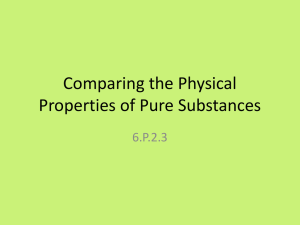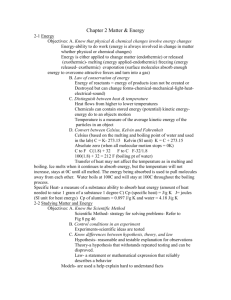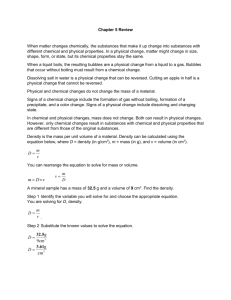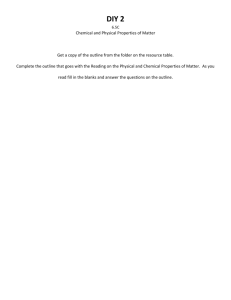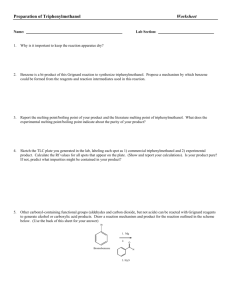Identifying of an Unknown Substance
advertisement
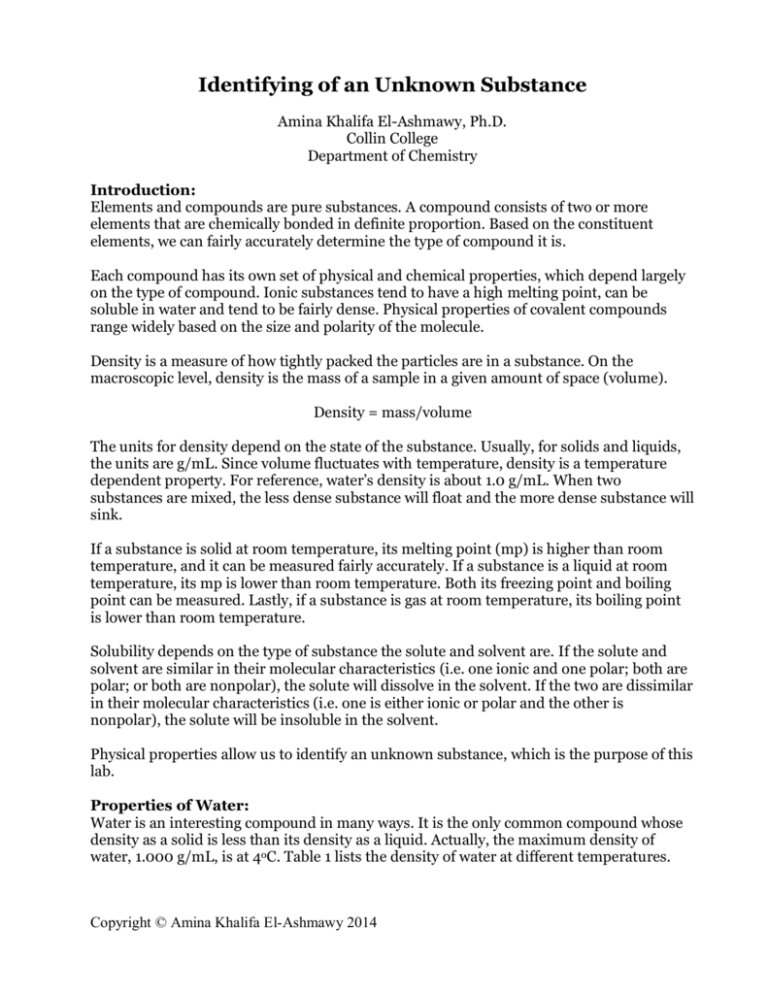
Identifying of an Unknown Substance Amina Khalifa El-Ashmawy, Ph.D. Collin College Department of Chemistry Introduction: Elements and compounds are pure substances. A compound consists of two or more elements that are chemically bonded in definite proportion. Based on the constituent elements, we can fairly accurately determine the type of compound it is. Each compound has its own set of physical and chemical properties, which depend largely on the type of compound. Ionic substances tend to have a high melting point, can be soluble in water and tend to be fairly dense. Physical properties of covalent compounds range widely based on the size and polarity of the molecule. Density is a measure of how tightly packed the particles are in a substance. On the macroscopic level, density is the mass of a sample in a given amount of space (volume). Density = mass/volume The units for density depend on the state of the substance. Usually, for solids and liquids, the units are g/mL. Since volume fluctuates with temperature, density is a temperature dependent property. For reference, water’s density is about 1.0 g/mL. When two substances are mixed, the less dense substance will float and the more dense substance will sink. If a substance is solid at room temperature, its melting point (mp) is higher than room temperature, and it can be measured fairly accurately. If a substance is a liquid at room temperature, its mp is lower than room temperature. Both its freezing point and boiling point can be measured. Lastly, if a substance is gas at room temperature, its boiling point is lower than room temperature. Solubility depends on the type of substance the solute and solvent are. If the solute and solvent are similar in their molecular characteristics (i.e. one ionic and one polar; both are polar; or both are nonpolar), the solute will dissolve in the solvent. If the two are dissimilar in their molecular characteristics (i.e. one is either ionic or polar and the other is nonpolar), the solute will be insoluble in the solvent. Physical properties allow us to identify an unknown substance, which is the purpose of this lab. Properties of Water: Water is an interesting compound in many ways. It is the only common compound whose density as a solid is less than its density as a liquid. Actually, the maximum density of water, 1.000 g/mL, is at 4oC. Table 1 lists the density of water at different temperatures. Copyright © Amina Khalifa El-Ashmawy 2014 Table 1. Density of Water at Various Temperatures Temperature (oC) 0 4 10 20 30 40 50 60 70 80 90 100 Density (g/mL) 0.9998 1.0000 0.9997 0.9982 0.9957 0.9922 0.9881 0.9832 0.9778 0.9718 0.9653 0.9584 Water forms a meniscus when placed in glass containers. A meniscus is the curve at the surface of a liquid that is close to the container. When measuring volume, one should be eye level with the meniscus and read the volume corresponding to the bottom of the meniscus for concave meniscus and at the top of the meniscus for a convex meniscus. Another interesting property of water is the wide range of temperature for which it exists as a liquid at standard pressure. Specifically, water’s melting or freezing point is at 0 oC while its boiling point at standard pressure is 100 oC. The last property we will address is water’s function as a solvent. In fact, water is considered the universal solvent because of its ubiquity on Earth. For solid substances that are not soluble in water (i.e. predominately nonpolar substances), water displacement can be used to determine the volume of those solids. The Problem: Each pair of students will have one solid and one liquid unknown to identify based on their physical properties. See Table 2. Measuring Melting Point and Boiling Point: To measure melting point, place your unknown in a test tube, suspend a thermometer just at the surface of the solid and insert the test tube into a beaker containing a hot water bath. Make sure the test tube is not pointed towards anyone. To measure boiling point, place your unknown in a test tube with one or two boiling chips, suspend a thermometer just above the surface of the liquid, and heat gently to boiling. Make sure the test tube is not pointed towards anyone. Copyright © Amina Khalifa El-Ashmawy 2014 Table 2. Physical Properties of Miscellaneous Substances Substance Borax Calcium carbonate Calcium nitrate Cyclohexane p-Dichlorobenzene Diphenylmethane Ethanol Heptane Hexane Iodomethane Lauric acid Methanol Naphthalene 2-Propanol Propanone Stearic acid Thymol p-Toluidine Trichloromethane Zinc nitrate Density (g/mL) 1.73 2.93 1.82 0.78 1.46 1.00 0.79 0.68 0.66 2.28 0.88 0.79 1.15 0.79 0.79 0.85 0.97 0.97 1.49 2.06 Melting Point (oC) 75 Dec 825 43 6.5 53 27 -112 -91 -94 -66 48 -98 80 -86 -95 70 52 45 -63.5 36 Boiling Point (oC) dec 200 dec dec 81 174 265 78 98 69 42 225 65 218 83 56 291 232 200 61 dec 105 Solubility Water Ethanol Sl-s I I I S S I S I S I S S S I Sl-s I S Sl-s S I S S S I Sl-s S S S S I Sl-s Sl-s S Sl-s S I S S S Note: Symbols used in this table are S = soluble, Sl-s = slightly soluble, I = insoluble, dec = decomposes. Values are rounded. Prelab Questions: What is a physical property? What properties does one use to identify a liquid substance? Solid? How do you measure the volume of a solid unknown substance that is either a powder or granular crystals? Is there a necessary order for measuring the physical properties? When observing solubility in the two solvents, what else will you be observing? What is the best way to measure melting point? Boiling point? (You should research this before coming to lab.) If an unknown has properties that are similar to more than one possible compound, what are some ways to distinguish the unknown? Critical Data/Discussion to Include in Your Lab Report: Data table showing melting point, boiling point, density and solubility, including unknown number and room temperature Discussion section that includes the answer to all questions posed above, the results, and the identity of your unknown substance along with its unknown number (if your unknown could be more than one substance based on Table 2, discuss the possible identities) Possible sources of error Works cited Copyright © Amina Khalifa El-Ashmawy 2014


